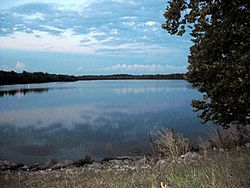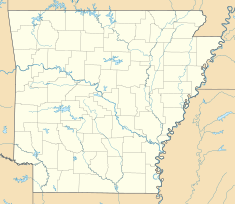Lake Fayetteville facts for kids
Lake Fayetteville is a reservoir of Clear Creek created by Lake Fayetteville Dam in 1949 in Fayetteville, Arkansas. Bordered on the north by Springdale, the lake was created as a water supply for the City of Fayetteville, but now serves as recreational lake surrounded by residential neighborhoods and as a focal point along the Razorback Regional Greenway for cyclists and trail users throughout Northwest Arkansas.
History
Lake Fayetteville was used as a water supply for Fayetteville until the creation of Beaver Water District, a regional provider whose source is Beaver Lake.
The Clear Creek watershed contains rapidly developing areas of both cities; as a result, stormwater washes sediment and dissolved nutrients into Lake Fayetteville, including nitrogen and phosphorus. The lake has undergone eutrophication, and occasionally has toxic algal blooms.
Amenities
Lake Fayetteville has a marina operated by the City of Fayetteville and fishing piers. The lake contains bass, crappie, carp, bluegill, and catfish.
The lake has long had a nature trail around the lake, including passing through the Botanical Garden of the Ozarks. The Lake Fayetteville Nature Trail is a dirt path with tree markers passing through the oak-hickory forest typical of the Ozark Mountains. The first segment of paved trail connecting to the Razorback Regional Greenway was completed in 2007, with a full 4.5 miles (7.2 km) paved trail around the lake completed in 2013. The nature trail was rehabilitated and expanded into a mountain biking trail beginning in 2010.
Students from Fayetteville Public Schools and Springdale Public Schools have jointly studied the water for biology and hydrology classes using the Springdale-Fayetteville Center for the Study of Aquatic Resources on the lake since 1974.
After an risk-based inspection by the Arkansas Natural Resources Commission describing a consequence of failure submerging the city of Johnson, Arkansas, the City of Fayetteville removed many large sycamore trees from the dam in 2017, and planted wildflowers.




